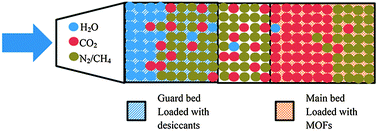Metal–organic frameworks (MOFs) have recently attracted intense research interest because of their permanent porous structures, large surface areas, and potential applications as novel adsorbents. The recent progress in adsorption-based CO2 capture by MOFs is reviewed and summarized in this critical review. CO2 adsorption in MOFs has been divided into two sections, adsorption at high pressures and selective adsorption at approximate atmospheric pressures. Keys to CO2 adsorption in MOFs at high pressures and low pressures are summarized to be pore volumes of MOFs, and heats of adsorption, respectively. Many MOFs have high CO2 selectivities over N2 and CH4. Water effects on CO2 adsorption in MOFs are presented and compared with benchmark zeolites. In addition, strategies appeared in the literature to enhance CO2 adsorption capacities and/or selectivities in MOFs have been summarized into three main categories, catenation and interpenetration, chemical bonding enhancement, and electrostatic force involvement. Besides the advantages, two main challenges of using MOFs in CO2 capture, the cost of synthesis and the stability toward water vapor, have been analyzed and possible solutions and path forward have been proposed to address the two challenges as well (150 references).

You have access to this article
 Please wait while we load your content...
Something went wrong. Try again?
Please wait while we load your content...
Something went wrong. Try again?


 Please wait while we load your content...
Please wait while we load your content...